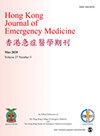Climatic factors influence on emergency department visits
IF 0.8
4区 医学
Q4 EMERGENCY MEDICINE
引用次数: 4
Abstract
Creative Commons Non Commercial CC BY-NC: This article is distributed under the terms of the Creative Commons Attribution-NonCommercial 4.0 License (http://www.creativecommons.org/licenses/by-nc/4.0/) which permits non-commercial use, reproduction and distribution of the work without further permission provided the original work is attributed as specified on the SAGE and Open Access pages (https://us.sagepub.com/en-us/nam/open-access-at-sage). Dear Editor, We read with great interest the editorial by Lim, Balsari and Hung recently published on Hong Kong Journal of Emergency Medicine.1 We do agree with the authors as they state that emergency physicians play a major role in preparing the communities for the challenges related to the climate change. In particular, we believe that emergency departments (EDs) offer a unique point of view on the health need of the population; moreover, the correlation between climatic factors and daily ED visits may represent a good model to understand the impact of climate on human morbidity.2 Thus, we conducted the analyses to determine the relationship between climatic factors and ED visits; we performed a retrospective study at the Santa Croce e Carle teaching hub hospital in Cuneo, north-west of Italy, over a 2-year period (1 January 2018 to 31 December 2020). Adults presenting to the ED for several pathologies were included. Data on mean barometric pressure, temperature and rain or snow were collected daily from a weather station located 1 km from the hospital. The relationship of daily or between-day (interday) changes in climatic factors and ED visits was evaluated using time series analysis. In the studied period, there were 151,787 total ED visits; here, we report all the correlations with a statistical significance (i.e. p ⩽ 0.05). Negative interday difference in barometric pressure, lower values of barometric pressure and lower temperature were associated with a decrease in daily ED accesses; in addition, we observed fewer ED accesses during rainy or snowy days. Lower temperature and negative variations in barometric pressure were associated with more ED admissions for respiratory diseases (asthma and chronic obstructive pulmonary disease exacerbations and pneumonia). Besides, we observed a positive correlation between barometric pressure differences and presentations for stroke; finally, lower values of barometric pressure were associated with a greater number of visits for psychiatric disorders. In conclusion, we can state that a correlation between weather factors and ED visits exists; this correlation is particularly strong for respiratory diseases. In the editorial’s conclusion, Lim and colleagues wonder if Emergency Medicine is ready to face the greatest challenge of our times. We believe that an important step is rising awareness among the society that climate is a fundamental determinant of health; fully understanding the interaction between climate and human morbidity may represent a way for coping with climate change.气候因素对急诊科就诊的影响
知识共享非商业CC BY-NC:本文根据知识共享归因非商业4.0许可条款分发(http://www.creativecommons.org/licenses/by-nc/4.0/)允许对作品进行非商业性使用、复制和分发,而无需进一步许可,前提是原始作品的归属符合SAGE和开放获取页面的规定(https://us.sagepub.com/en-us/nam/open-access-at-sage)。尊敬的编辑,我们饶有兴趣地阅读了Lim、Balsari和Hung最近发表在《香港急诊医学杂志》上的社论。1我们同意作者的观点,因为他们表示,急诊医生在为社区应对气候变化相关挑战做好准备方面发挥着重要作用。特别是,我们认为急诊科对人们的健康需求有着独特的看法;此外,气候因素与每日急诊就诊的相关性可能是了解气候对人类发病率影响的一个很好的模型。2因此,我们进行了分析,以确定气候因素与急诊就诊之间的关系;我们在意大利西北部库内奥的Santa Croce e Carle教学中心医院进行了为期2年(2018年1月1日至2020年12月31日)的回顾性研究。包括因多种病理向急诊科就诊的成年人。每天从距离医院1公里的气象站收集平均气压、温度和雨雪数据。使用时间序列分析来评估气候因素的每日或日间(日间)变化与ED就诊的关系。在研究期间,共有151787次急诊就诊;在这里,我们报告了所有具有统计学意义的相关性(即p⩽0.05)。大气压的负日差、较低的大气压值和较低的温度与每日ED访问量的减少有关;此外,我们在雨天或雪天观察到ED访问次数减少。较低的温度和气压的负变化与呼吸系统疾病(哮喘和慢性阻塞性肺病恶化和肺炎)的ED入院人数增加有关。此外,我们观察到大气压差与中风表现之间呈正相关;最后,气压值越低,精神疾病就诊次数越多。总之,我们可以指出,天气因素与急诊就诊之间存在相关性;这种相关性对于呼吸系统疾病尤其强烈。在社论的结论中,林和同事们想知道急诊医学是否准备好面对我们时代的最大挑战。我们认为,重要的一步是提高社会对气候是健康的根本决定因素的认识;充分了解气候与人类发病率之间的相互作用可能是应对气候变化的一种方法。
本文章由计算机程序翻译,如有差异,请以英文原文为准。
求助全文
约1分钟内获得全文
求助全文
来源期刊

Hong Kong Journal of Emergency Medicine
EMERGENCY MEDICINE-
CiteScore
1.50
自引率
16.70%
发文量
26
审稿时长
6-12 weeks
期刊介绍:
The Hong Kong Journal of Emergency Medicine is a peer-reviewed, open access journal which focusses on all aspects of clinical practice and emergency medicine research in the hospital and pre-hospital setting.
 求助内容:
求助内容: 应助结果提醒方式:
应助结果提醒方式:


